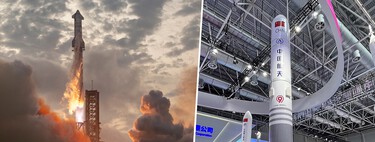SpaceX is finalizing preparations to launch the Starship rocket for the fifth time this Sunday after a successful flight last June. The company will try to catch the gigantic launcher with the launch tower’s mechanical arms. It’s an incredibly risky move, but SpaceX has reason to be optimistic.
Context. At 120 meters high, Starship is the largest and most powerful rocket ever built. It consists of two stages: the Super Heavy booster (with 33 Raptor 2 engines and 70 meters) and the Starship ship (with six engines and 50 meters).
Although it has not yet reached its full potential, the Starship system is designed to launch more than 100 tons into low Earth orbit and reach the Moon or Mars. Its full reusability will be key to reducing launch costs and increasing the frequency of its space flights.
The deadly triple of the Super Heavy. During Starship’s fourth flight, the Super Heavy booster survived the separation and spin maneuver away from the Starship stage for the first time, restarting its engines and successfully simulating a landing in the Gulf of Mexico.
SpaceX accepted this single simulated landing and announced that during the fifth flight it would try to catch the Super Heavy with the mechanical arms of the launch tower. The rocket will report its state of health and, if the flight director approves, it will return in a controlled manner to the SpaceX facilities in southeast Texas, placing itself next to the 140-meter-high tower so that it closes its arms and catch on the fly.
An accuracy of half a centimeter. The reason it took SpaceX no more than one successful attempt to risk the tower with the dangerous maneuver of catching the rocket is that the fourth flight was incredibly precise.
Bill Gerstenmaier, vice president of construction and flight reliability at SpaceX, revealed on Wednesday that the Super Heavy booster from Flight 4 landed at a certain point in the Gulf of Mexico with an accuracy of half a centimeter. It is an impressive figure for a 70-meter rocket. And of course, it gives them confidence to take action without doing more simulations.

Why doesn’t it land on the ground. Unlike the Falcon 9, the Super Heavy does not have retractable landing legs. It is a rocket so large and heavy that it would require enormous legs, which would reduce Starship’s payload capacity or force it to add even more fuel capacity.
Trapping it with the arms of the tower (Mechazilla) has another motivation: it allows you to immediately place the rocket on the launch pad, fill it with fuel and put another Starship on top to take off again. That is, it allows rapid reuse similar to that of an airplane that SpaceX longs for.
The landing could be aborted. Once the Super Heavy separates from the Starship, which will continue on its way to another simulated landing in the Indian Ocean, SpaceX will make the decision to approve or cancel the booster capture maneuver.
The process will depend on thousands of criteria, such as whether all systems are working perfectly, including those at the launch site. If something is not in optimal conditions, the rocket, instead of returning to the launch site, will land again in the Atlantic.
Almost everything ready. With the explosives of flight termination system Already installed, everything is ready for takeoff. Except for the flight license, which was scheduled for the end of November, but apparently will end up being brought forward.
If there are no delays and the FAA flight license arrives on time, Starship Flight 5 will take off at 7:00 a.m. Sunday local time at Starbase, Texas. That is, at 2:00 p.m. in Spain. In addition to the Super Heavy, SpaceX hopes that the Starship stage will also survive its reentry maneuver thanks to a more sophisticated and resistant heat shield than that of the previous flight.
Image | SpaceX
In Xataka | SpaceX always gets what it wants: the most controversial Starship launch has been brought forward to this week
















Add Comment